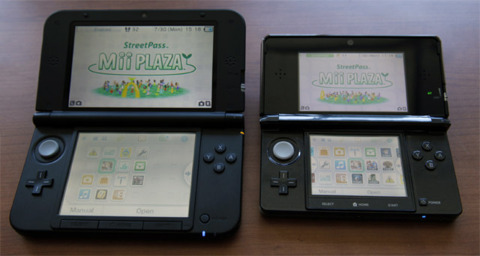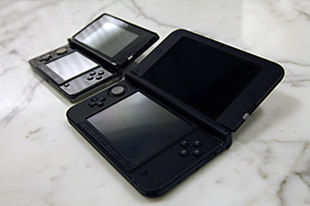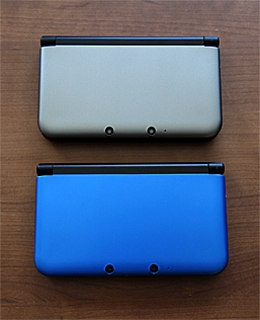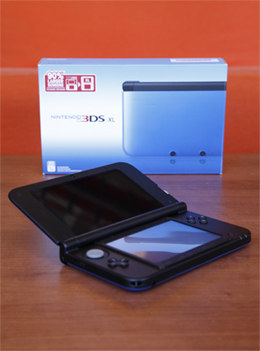The 3DSXL is an improvement, but it's not without its flaws
Nintendo's upgraded 3DS will hit shelves in a few weeks, with a larger screen, better battery-life, more memory, and sadly, a few minor design flaws.
The 3DSXL has landed at GameSpot and from the look of things, it's an improvement over the 3DS in almost every way. Beyond the increase in size, the improvements to ergonomics, screen glare, and battery life make the original model look quaint in comparison. There are a few minor issues that might bug perfectionists, but in all other regards, it's a solid handheld and a welcome upgrade all around.
Fallout 4 Next Gen Update Comparison Stellar Blade - Hard Mode No Damage Gigas Boss Gameplay Stellar Blade - Hard Mode No Damage Abaddon Boss Gameplay Stellar Blade - (Almost) All Outfits Granblue Fantasy: Relink - New Content Trailer Modern Warfare III - New Season 3 Reloaded Modern Warfare Zombies Update River City Girls 2 - New Playable Characters DLC Reveal!! That Time I Got Reincarnated as a Slime ISEKAI Chronicles – Official Announcement Trailer MEGATON MUSASHI W: WIRED – Official OP “MUSASHI English Ver.” Trailer Gothic 1 Remake | Official Collector's Edition Trailer SaGa Emerald Beyond – Official Launch Trailer Paper Mario: The Thousand-Year Door – Official Switch Overview Trailer
Please enter your date of birth to view this video
By clicking 'enter', you agree to GameSpot's
Terms of Use and Privacy Policy
The most notable improvement is the 90% increase in screen surface area. The actual unit is only 3/4" longer, and 1 3/8" wider, falling just shy of the DSiXL's girth. Thickness remains the same at 3/4" when closed. Here's a complete breakdown of the new dimensions
| Model | Length | Width | Height | Top Screen (Diag.) | Bottom Screen (Diag.) | Weight |
|---|---|---|---|---|---|---|
| 3DS | 5.25" | 2.875" | 0.75" | 3.5" | 3" | 8.3 oz |
| 3DSXL | 6" | 3.5" | 0.75" | 4.875" | 4.25" | 11.5 oz |
Now that edges and corners are rounded, and the entire chassis is more robust, the 3DSXL is much easier on the hands. Aesthetically speaking though, the original is shinier and more eye-catching compared to the subdued exterior and matte interior of the 3DSXL, but it's also better at picking up finger prints. This should go without saying, but the new matte finish also does away with the issue of universal glare, plaguing almost every surface of the 3DS.

The reported 30% reduction in on-screen glare, while difficult to measure, is immediately noticeable. Though a modest amount remains, it's much less common to slip out of focus, staring at yourself rather than gameplay. This, plus the larger screens, have seemingly increased the 3D sweet-spot as well, but keep in mind, this is a subjective analysis. Results are guaranteed to vary from person to person, so it may be best to try out an in-store demo unit before committing to the XL.
For those who felt the previous 3D slider was a little too loose, you'll be happy to know the revised slider snaps into the off position, preventing accidental activation.
 Though the screens are larger, their resolution remains the same. Because of this, pixel density takes a hit, making every pixel and scan-line quite noticeable upon close examination. During gameplay however, at a natural distance, this is less of an issue. 3DS games look great, and now that the XL is on the market, it's fair to assume developers will begin designing with the increased real estate in mind. Lovers of DS games fear not: they suffer less than you might imagine, given the additional stretching, appearing clear and vibrant.
Though the screens are larger, their resolution remains the same. Because of this, pixel density takes a hit, making every pixel and scan-line quite noticeable upon close examination. During gameplay however, at a natural distance, this is less of an issue. 3DS games look great, and now that the XL is on the market, it's fair to assume developers will begin designing with the increased real estate in mind. Lovers of DS games fear not: they suffer less than you might imagine, given the additional stretching, appearing clear and vibrant.
The extra weight on the 3DSXL is primarily due to a larger battery, which is now positioned in the center of the unit. You can expect a maximum of 6.5 hours of 3DS gameplay and 10 hours when playing DS games. In addition to dispersing weight in a more reasonable manner, the new position also allows the stylus to fit on the right-hand side, negating the need for the ole' 3DS stylus reach around. Nintendo also decided to ditch the telescopic design, opting instead for a static, single-length stylus, which falls just under a 1/4'' shy of the original in length.
 They've gone ahead and relocated the SD slot as well, and this is where the XL begins to show its flaws. It's similar to the old style, but opening the new latch is notably difficult by comparison. The worst part is that it tends to lift up a section of the bottom panel. It's a step-down in terms of build quality, and the only saving grace is the fact that one rarely needs to change SD cards, if ever.
They've gone ahead and relocated the SD slot as well, and this is where the XL begins to show its flaws. It's similar to the old style, but opening the new latch is notably difficult by comparison. The worst part is that it tends to lift up a section of the bottom panel. It's a step-down in terms of build quality, and the only saving grace is the fact that one rarely needs to change SD cards, if ever.
The only other obvious flaw would be the purportedly improved "Select", "Home", and "Start", buttons. It's nice that each button is physically independent now, but they are quite stiff and the tactile response feels mushy, at best. In other words, it feels like a step sideways, rather than forward.
The rest of the hardware is pretty much the same as the original 3DS. The speakers, camera, and buttons (outside of the home bar) are comparable. The only discernable differences are the increased grip of the Circle Pad and a slightly more concave D-Pad.
Unfortunately, transferring software between systems is not as simple as swapping SD cards. According to the manual, system data is transferred wirelessly between handhelds, using the "System Transfer" option in the "Other Settings" menu. The downside to the process is that you can only transfer your eShop account a total of 5 times.
 Similarly disappointing, though not surprising, is the fact that the same software and eShop account can't live on two systems simultaneously. Essentially, you transfer your eShop account from one system to the other and swap SD cards to continue playing your games on the target system. If you want to recopy your data to the source system, you have to wait a full week to do so. That's pretty inconvenient and doesn't quite encourage ownership of multiple 3DS's. That may not be a problem for most people, but some customers might find it advantageous to own multiple form factors. The weeklong buffer is damning, but the data transfer limit seals that window of opportunity completely shut.
Similarly disappointing, though not surprising, is the fact that the same software and eShop account can't live on two systems simultaneously. Essentially, you transfer your eShop account from one system to the other and swap SD cards to continue playing your games on the target system. If you want to recopy your data to the source system, you have to wait a full week to do so. That's pretty inconvenient and doesn't quite encourage ownership of multiple 3DS's. That may not be a problem for most people, but some customers might find it advantageous to own multiple form factors. The weeklong buffer is damning, but the data transfer limit seals that window of opportunity completely shut.
If you are an existing 3DS owner, you have a few things to consider before upgrading, namely, the associated costs and unfortunate burden that is your current 3DS. For anyone else, the difference of $30 nets a handheld with improved ergonomics, larger screens, and longer battery life than it's diminutive cousin. Until there's is a price drop on the original 3DS, picking up the 3DSXL instead should be a foregone conclusion for most consumers.
The 3DSXL from Nintendo ships August 19th with an MSRP of $199.99, and is available in either Blue or Red. The North American model ships with an AC adapter (unlike the European and Japanese versions), with all regions receiving a 4GB SDHC flash card pre-loaded in the system.
Got a news tip or want to contact us directly? Email news@gamespot.com
Join the conversation